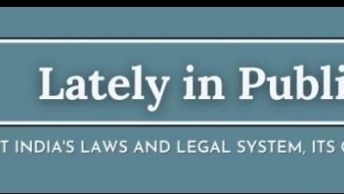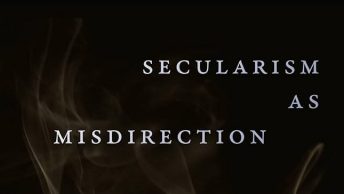Since Mr. Venkatesan is such a forensic interpreter of our Court’s jurisprudence and the larger political canvass regarding reservations, I would like him to elaborate his assertion that the creamy-layer requirement under Article 16 (4) is to be handled differently under Article 15 (4). I, for one, am unable to comprehend what “peculiar differences” exist between jobs and educational seats that would make the creamy-layer requirement apply to one type of reservations and not to the other. As Pratap Bhanu Mehta says, the government has failed to articulate a proper justification to avoid the creamy layer issue in education.
I must admit I have not read the recent cases on reservations quite carefully as I have wandered away from that field for a few years. Yet, having studied the subject quite intently earlier, I question whether it is appropriate to confine Indira Sawhney’s creamy-layer requirement to only public employment. I cannot recall anything in Justice Jeevan Reddy’s majority decision for the constitution bench that limited “skimming” the creamy layer to jobs. It is true that the underlying case involved the constitutional validity of the 1990 office memos implementing the Mandal recommendations. But, if I recall correctly, the matter was first placed before a constitution bench of five judges. It was subsequently referred to a nine-judge bench “with a view to finally settle the legal position relating to reservation.”
With this mandate, the judges in Indira Sawhney covered a wider canvas of issues than just that the validity of the office memos implementing the Mandal recommendations. In fact, during the hearings, the government’s lawyers asked the court not to consider reservation in promotion for SCs and STs on the ground that the issue was not before the Court. The Court rejected that objection and proceeded to overrule Rangachari’s Case, which ultimately resulted in a constitutional amendment. Therefore, I am unconvinced by attempts to restrict the scope of Indira Sawhney’s holding to Article 16 (4), which I must say, was a fair and balanced decision given the competing constitutional interests at stake.






After reading Mr.Venkatesan’s earlier comments, I went back and read the GoI application to vacate the stay. It does deal with many reasons why creamy layer cannot be applied to admissions. I am not sure however they can be called ‘weighty’.
Without characterising them further I would like to wait for
Mr.Venkatesan’s response. However I do want to say that all those reasons are dire predictions of the effects of excluding creamy layer.
And none of them even remotely try to offset the essential equality aspect, which is the doctrinal basis for creamy layer in Indra Sawhney, in the first place.
The nine judges in Mandal Commission case have dealt with issues relating to reservation
including reservation in employment. Eight judges favored exclusion of creamy layer while only one judge (J.Ratnavel Pandian) was against such exclusion.In all subsequent
judgments on reservation the exclusion was affirmed. If the
judgment in Mandal Commission
is taken as the basis then there
is no logic or rationale to include
creamy layer. That judgment can be
a starting point but need not be
taken as the final word. Many issues were not discussed then,
particularly the rationale and
limits for reservation in education. Remember
that Mandal Commission report was
submitted in early eighties, the
judgment came in 1992 and now 25 years have passed since the Report
was submitted. And Mandal Commission used 1931 census data.
Much water has flown in Ganges
during these years. Hence the
relevance of Mandal Commission Report is limited now.I would say
that it deserves a decent burial
now :).
Dear Vikram,
YOu may already know that in Indira Sawhney II, it was settled that the creamy layer cannot access the OBC quota. The reason had nothing to do with jobs vs education. The reason is social justice and the need to maintain the compactness of the OBC group. Creamy layer individuals have snapped their ties with the backward group. Including them will “leave the truly backward backward for ever”.
(see J. Jeevan Reddy in Indira Sawhney II at this link Creamy layer – A Kerala Story
The bigger issue is the nature of the OBC category itself. Even if one were to assume that caste can be used to substitute for class for purposes of quota, there are several unanswered questions.
Read this in the context of the two primary questions.
1) How does a given caste get to be a member of the OBC group ?
2) How does a given caste once in, keep or renew its membership ?>
Lets attempt to look at them from the angle of educational quotas.
A fair enough argument is that a caste that does not have “any disabilities” cannot be a member of the OBC group. That is fine, but “absence of disabilities” is something that cannot be measured. It is emotional and cannot be actioned upon. For example, consider a caste group that claims that “they have been left shattered by thousands of years of the most vicious oppression”. How do you wrap your head around that claim ?
However, the “presence of abilities” test is something that can be administered. The courts have mentioned this point in various rulings, without actually calling for a measurement. ( link )
Shorn of fancy wording, this means that if a particular caste is able to secure adequate (not necessarily proportional representation) is the open competition, than there is no case for further reservation for that particular caste. Why ? Because it would be detrimental to the other castes that have not demonstrated the above “presence of abilities”. In addition, it would also hammer the constitutional guarantees of equality by furthering the unequal treatment of equals. We would be beyond the zone of affirmative action and firmly into reverse discrimination.
So whats the way out ? The key point is measurement of castes that are members of the OBC lists. Yes, we know the NCBC did not do that in 2003 because it felt that 10 years was too short for excluding anyone. Unfortunately that line is completely besides the point.
The exclusion of dominant castes is not the central issue, the measurement is. Ten years may be too short for exclusion, but even one year is good enough for measurement. Just one look at how the US collects and publishes data on affirmative action programs must be an eye opener. Without such measurement, how can we ascertain how the system is working ?
I feel the time for the third backward classes commission has arrived.
In the interest of true social justice and to prevent caste justice this commission should take this program forward in the age of the internet and free information.
Looking forward to your comments,
Dear Mr.Srinivasan, I agree that GOI’s reasons are dire predictions of the effects of excluding creamy layer. But these predictions have been suggested by ground realities in various States, and on the face of it, they are persuasive. Whether these reasons offset the essential equality aspect – the doctrinal basis of creamy layer in Indra Sawhney – I think you are entitled to your view on this. Though I find your view compelling, I would like to await the hearing from May 8 to make up mind.